DOI:10.29111/ijlrst ISRA Impact Factor:3.35, Peer-reviewed, Open-access Journal
Research Paper Open Access
International Journal of Latest Research in Science and Technology Vol.7 Issue 2, pp 22-27,Year 2018
Correspondence should be addressed to :
Received : 16 March 2018; Accepted : 24 April 2018 ; Published : 15 April 2018

| Download | 125 |
|---|---|
| View | 180 |
| Article No. | 10777 |
Malvasylvestrisis an annual plant native to Europe, North Africa and Asia. This herbaceous species has a long history, it has been used widely as food due to its therapeutic relevance. Some parts of this plant have been employed in traditional medicine, the leaves are perfectly safe and that there are no negative effects for human consumption, although some authors have reported harmful effects due to the growth of mauve in contaminated areas. In this study the content of heavy metals was analysed in various herbal products based on M. sylvestris obtained from different European countries. The analysis conducted included elements such as arsenic, cadmium, lead and mercury.The metals were found in various concentrations with the following ranges: 0.012-0.068 mg/kg-1 for arsenic, 0.116-0.339 mg/kg-1 for cadmium, 0.096-0.271 mg/kg-1 for lead, while the mercury concentrations are below the detection limits. According to our results, in all samples the arsenic and mercury levels are below both the permissible limits provided by European Commission on the maximum content of contaminants in foodstuffs and the international limits provided by FAO/WHO for medicinal herbs and plants. Instead, non-negligible concentrations of cadmium and lead were detected, especially in the samples from South Mediterranean areas. The relationship between the contaminants and the sampling sites was investigated using analysis of variance (ANOVA) and Tukey’s HSD post-hoc tests. Finally, the Estimated Daily Intake (EDI) and the Health Risk Index (HRI) were calculated to evaluate the potential health risk from mauve products chronic consumption. Health Risk Index values resulted lower than 1, indicating that there were no risks to human health.
Copyright © 2018 Ilenia Bravo et al. This is an open access article distributed under the Creative Commons Attribution 4.0 International (CC BY 4.0) license which permits unrestricted use, distribution, and reproduction in any medium, provided the original work is properly cited.
Ilenia Bravo ,Papetti Patrizia, Spognardi Sara, Carelli Angela, Pelagalli Ester , " Contamination From Heavy Metals In The Erboristic Preparations Of Malva Sylvestris ", International Journal of Latest Research in Science and Technology . Vol. 7, Issue 2, pp 22-27 , 2018

MNK Publication was founded in 2012 to upholder revolutionary ideas that would advance the research and practice of business and management. Today, we comply with to advance fresh thinking in latest scientific fields where we think we can make a real difference and growth now also including medical and social care, education,management and engineering.

We offers several opportunities for partnership and tie-up with individual, corporate and organizational level. We are working on the open access platform. Editors, authors, readers, librarians and conference organizer can work together. We are giving open opportunities to all. Our team is always willing to work and collaborate to promote open access publication.

Our Journals provide one of the strongest International open access platform for research communities. Our conference proceeding services provide conference organizers a privileged platform for publishing extended conference papers as journal publications. It is deliberated to disseminate scientific research and to establish long term International collaborations and partnerships with academic communities and conference organizers.